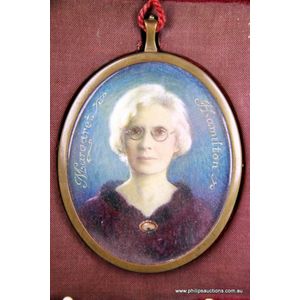William IV Library Chair with Green Leather Upholstery
You must be a subscriber, and be logged in to view price and dealer details.
Subscribe Now to view actual auction price for this item
When you subscribe, you have the option of setting the currency in which to display prices to $Au, $US, $NZ or Stg.
- Turning - Any part of a piece of furniture that has been turned and shaped with chisels on a lathe. Turned sections include legs, columns, feet, finials, pedestals, stretchers, spindles etc. There have been many varieties and fashions over the centuries: baluster, melon, barley-sugar, bobbin, cotton-reel, rope-twist, and so on. Split turning implies a turned section that has been cut in half lengthwise and applied to a cabinet front as a false decorative support.
- William Iv - William IV was King of the United Kingdom and King of Hanover from 26 June 1830 until his death in 1837, and in English furniture design it represented the brief period between the end of the Regency period, and the beginning of the Victorian period.
- Mahogany - Mahogany is a dense, close grained red-coloured timber from the West Indies and Central America. It was first imported into Europe in the the early 18th century and its use continued through the 19th century. It was popular for furniture making because of its strength, the wide boards available, the distinctive grain on some boards, termed flame mahogany and the rich warm colour of the timber when it was polished.. The "flame" was produced where a limb grew out from the trunk of the tree, and this timber was usually sliced into veneers for feature panels on doors, backs and cornices.
Some terms used to describe mahogany relate to the country from which it originally came, such as "Cuban" mahogany, "Honduras" mahogany etc. However unless the wood has been tested the names assigned are more a selling feature, rather than a true indication of the timber's origin.
This item has been included into following indexes:
-
chairs, singles / pairs / threes, style or period
- bergères (armchairs) 166
- Colonial 108
- desk 288
- library 288
- office 288
- William IV 122
- chairs, singles / pairs / threes, timber - mahogany 1,098
Visually similar items

Victorian gold stick pin milk opal head with two opal pendant drops

A pair of 19th century bronze two-handled urns of classical Etruscan style, modelled with boar's heads and classical masks. Height 22 cm

A transitional style walnut and tulipwood marquetry commode, late 19th century, with a white and grey marble breakfront top with a long shallow drawer and two deeper drawers with cross banding, stringing and a central medallion enclosing an inlaid basket o

A fine portrait miniature, mid 20th century, attributed to Lisa de Montfort, b. 1906, in oil, a delicate and sensitively rendered portrait of Margaret Hamilton, wife of David William Hamilton, and set within a brass frame in a velvet and leather display ca
